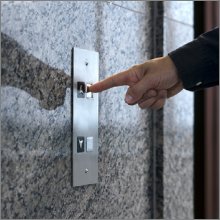|
|

|

The Dangers of Escalators & Elevators (and How to Be Safe on These Top Sources for Germs and Injuries)
by www.SixWise.com Elevators and escalators are a convenient and, when used
carefully, fairly safe way to travel from one building floor
to another. However, they are not without, quite serious,
risks.
|

Children and adults can get caught in-between escalator
steps and sides, leading to serious injury, including
lost fingers and toes.
|
Nearly 10,000 people visit the emergency room each year because
of escalator accidents, according to CBS News. Meanwhile,
from 1992-2001 the U.S. Consumer Product Safety Commission
(CPSC) reported 20 non-work related deaths of escalator passengers
and 39 non-work related deaths of elevator passengers.
Knowing the risks to watch out for, and taking the following
safety precautions, can keep you and your children free from
harm.
Top Elevator and Escalator Risks
- Falls: The most deadly
fall risk is falling into an elevator shaft when an
elevator call button is pushed and the doors opened, but
no elevator was at the floor. However, more commonly fall
injuries on elevators occur from tripping when an elevator
doesn't stop flush with the floor on which the door is opening.
Falls on escalators are also common, with CPSC estimating
that 75 percent of escalator injuries result from falls
(such as tripping).
- Getting Caught: One of the most serious escalator
risks, which account for 20 percent of the injuries according
to CPSC, is from being caught in or between the bottom or
top of an escalator, or between a moving stair and escalator
sidewall.
Young children are at particular risk of getting their
hands, shoes (or dangling shoelaces) or clothing caught
in the escalator, but adults' clothing can get trapped
as well. When an item gets caught in the moving elevator,
it quickly gets sucked in with incredible force. There
are numerous reports each year of children losing toes
or fingers because of this risk.
-
Malfunctions: Malfunctions in escalators and
elevators also result in injury. For instance, injuries
have been reported when an escalator malfunctioned and
quickly sped up or reversed its direction of movement.
-
Germs: Elevators and escalators are among the
germiest public places. Elevator buttons, and particularly
the popular first-floor button, are loaded with germs.
According to Charles Gerba, Ph.D., professor of microbiology
at the University of Arizona, "If you can, let someone
else push it so you don't have to touch it."
Escalator handrails are also germ
havens, and Gerba advises to avoiding touching them as
well, if you can avoid it.
|

The first-floor elevator button is usually the germiest
(because it's used most often). Avoid touching it (let
someone else punch it), and if you must push it use
a barrier like a PerfectClean
Handwipe.
|
However, holding onto the handrail is an important safety
tip to reduce your risk of tripping on an escalator, so instead
of not holding on at all, we recommend using a PerfectClean
Handwipe as a barrier. These handwipes are small enough
to carry in your pocket and are simple to use between your
hand and the escalator handrail.
Because they are made with commercial, hospital-grade ultramicrofiber
that picks up even the germs you can't see with your naked
eye, they're incredibly effective. You can also use them to
push elevator buttons, and to wipe your hands off after the
fact.
Elevator and Escalator Safety Tips
Sometimes you can't avoid riding on an elevator or escalator
(such as if you're pushing a stroller or need to travel up
25 stories), but you can prevent most of the potential injuries
by following these simple safety tips:
-
Look before you leap. Before entering an elevator,
make sure it's there and that it's flush with the floor,
and when you step onto an escalator, look to make sure
the step is flat and fully extended.
-
Hold the handrails. This will help you stay steady
on an escalator, and you can avoid germs by using a PerfectClean
Handwipe between your hand and the railing. Small
children should hold onto your hand.
-
Stand in the middle of the step, and don't lean on
the side. This keeps you away from the sides, where
clothing, hands and feet can get caught.
-
Keep clothing, shoelaces, handbags and shopping bags
away from the sides of escalators. If your child's
shoes are untied, be sure to tie them before getting on.
-
Watch children carefully. Keep them safely in
the middle of an escalator step, hold their hand firmly,
and never let them play on or near an elevator or escalator.
-
Avoid germs. Avoid touching elevator buttons or
escalator handrails without using a barrier like a PerfectClean
Handwipe. If you do touch the surface, be sure to
wash
your hands thoroughly afterward as soon as possible.
Recommended Reading
What
are the Least Safe Foods From a Contamination Perspective?
The
Nine Grossest Things Other People Do That Can Make You Sick
Sources
Electronic
Library of Construction Occupational Safety and Health
CBSNews.com
NewsMax.com
To get more information about this and other highly important topics, sign up for your free subscription to our weekly SixWise.com "Be Safe, Live Long & Prosper" e-newsletter.
With every issue of the free SixWise.com newsletter, you’ll get access to the insights, products, services, and more that can truly improve your well-being, peace of mind, and therefore your life!
|
|
|
|